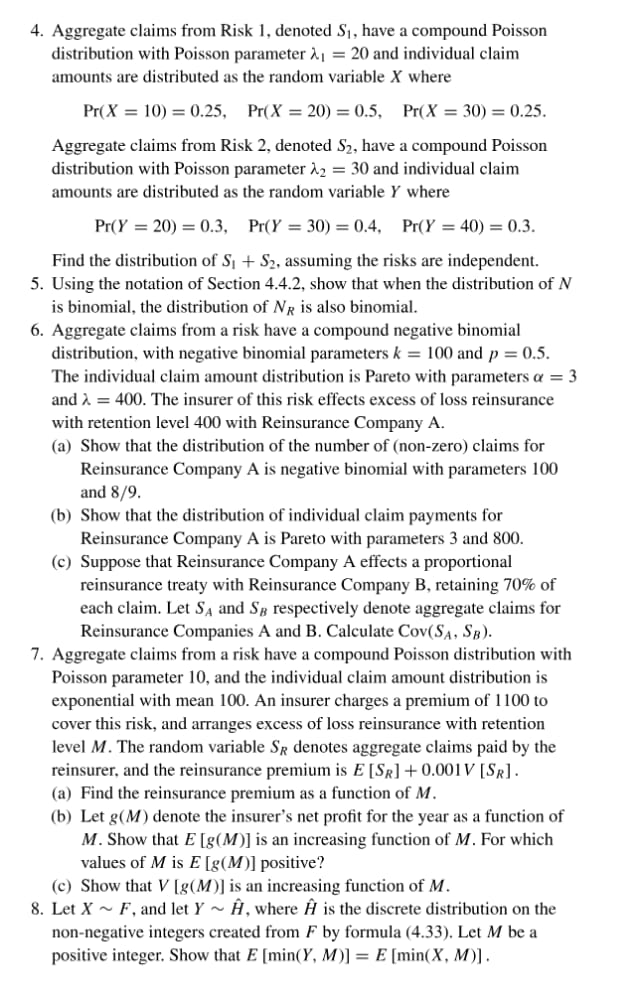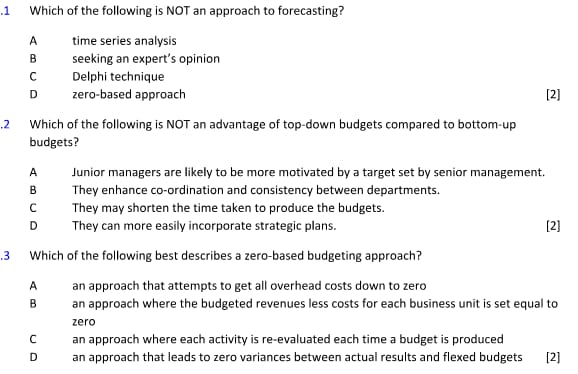

4. Aggregate claims from Risk 1, denoted $1, have a compound Poisson distribution with Poisson parameter 2, = 20 and individual claim amounts are distributed as the random variable X where Pr(X = 10) = 0.25, Pr(X = 20) = 0.5, Pr(X = 30) = 0.25. Aggregate claims from Risk 2, denoted $2, have a compound Poisson distribution with Poisson parameter 22 = 30 and individual claim amounts are distributed as the random variable Y where Pr(Y = 20) = 0.3, Pr(Y = 30) = 0.4, Pr(Y = 40) = 0.3. Find the distribution of S, + $2, assuming the risks are independent. 5. Using the notation of Section 4.4.2, show that when the distribution of N is binomial, the distribution of NR is also binomial. 6. Aggregate claims from a risk have a compound negative binomial distribution, with negative binomial parameters & = 100 and p = 0.5. The individual claim amount distribution is Pareto with parameters a = 3 and > = 400. The insurer of this risk effects excess of loss reinsurance with retention level 400 with Reinsurance Company A. (a) Show that the distribution of the number of (non-zero) claims for Reinsurance Company A is negative binomial with parameters 100 and 8/9. (b) Show that the distribution of individual claim payments for Reinsurance Company A is Pareto with parameters 3 and 800. (c) Suppose that Reinsurance Company A effects a proportional reinsurance treaty with Reinsurance Company B, retaining 70% of each claim. Let SA and Sg respectively denote aggregate claims for Reinsurance Companies A and B. Calculate Cov(SA, SB). 7. Aggregate claims from a risk have a compound Poisson distribution with Poisson parameter 10, and the individual claim amount distribution is exponential with mean 100. An insurer charges a premium of 1100 to cover this risk, and arranges excess of loss reinsurance with retention level M. The random variable SR denotes aggregate claims paid by the reinsurer, and the reinsurance premium is E [SR] + 0.001V [SR]. (a) Find the reinsurance premium as a function of M. (b) Let g( M) denote the insurer's net profit for the year as a function of M. Show that E [g(M)] is an increasing function of M. For which values of M is E [g(M)] positive? (c) Show that V [g(M)] is an increasing function of M. 8. Let X ~ F, and let Y ~ H, where H is the discrete distribution on the non-negative integers created from F by formula (4.33). Let M be a positive integer. Show that E [min(Y, M)] = E [min(X, M)].1 Which of the following is NOT an approach to forecasting? A time series analysis B seeking an expert's opinion Delphi technique zero-based approach [2] .2 Which of the following is NOT an advantage of top-down budgets compared to bottom-up budgets? A Junior managers are likely to be more motivated by a target set by senior management. B They enhance co-ordination and consistency between departments. C They may shorten the time taken to produce the budgets. They can more easily incorporate strategic plans. [2] 3 Which of the following best describes a zero-based budgeting approach? A an approach that attempts to get all overhead costs down to zero B an approach where the budgeted revenues less costs for each business unit is set equal to zero C an approach where each activity is re-evaluated each time a budget is produced D an approach that leads to zero variances between actual results and flexed budgets [2]










